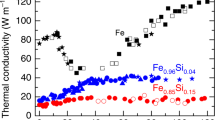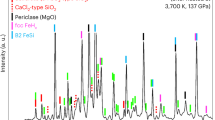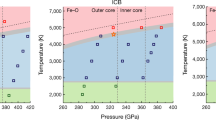Abstract
The boundary between the Earth's metallic core and its silicate mantle is characterized by strong lateral heterogeneity and sharp changes in density, seismic wave velocities, electrical conductivity and chemical composition1,2,3,4,5,6,7. To investigate the composition and properties of the lowermost mantle, an understanding of the chemical reactions that take place between liquid iron and the complex Mg-Fe-Si-Al-oxides of the Earth's lower mantle is first required8,9,10,11,12,13,14,15. Here we present a study of the interaction between iron and silica (SiO2) in electrically and laser-heated diamond anvil cells. In a multianvil apparatus at pressures up to 140 GPa and temperatures over 3,800 K we simulate conditions down to the core–mantle boundary. At high temperature and pressures below 40 GPa, iron and silica react to form iron oxide and an iron–silicon alloy, with up to 5 wt% silicon. At pressures of 85–140 GPa, however, iron and SiO2 do not react and iron–silicon alloys dissociate into almost pure iron and a CsCl-structured (B2) FeSi compound. Our experiments suggest that a metallic silicon-rich B2 phase, produced at the core–mantle boundary (owing to reactions between iron and silicate2,9,10,13), could accumulate at the boundary between the mantle and core and explain the anomalously high electrical conductivity of this region6.
This is a preview of subscription content, access via your institution
Access options
Subscribe to this journal
Receive 51 print issues and online access
$199.00 per year
only $3.90 per issue
Buy this article
- Purchase on Springer Link
- Instant access to full article PDF
Prices may be subject to local taxes which are calculated during checkout



Similar content being viewed by others
References
Gurnis, M., Wysession, M. E. & Knittle, E. The Core-Mantle Boundary Region (ed. Buffett, B. A.) (AGU, Washington DC, 1998)
Jeanloz, R. & Williams, Q. in Ultrahigh-Pressure Mineralogy: Physics and Chemistry of the Earth's Deep Interior (ed. Hemley, R. J.) Rev. Mineral., 37, 241–259 (1998).
Buffett, B. A., Garnero, E. J. & Jeanloz, R. Sediments at the top of Earth's core. Science 290, 1338–1342 (2000)
Li, J. & Agee, C. B. Geochemistry of mantle–core differentiation at high pressure. Nature 381, 686–689 (1996)
Vidale, J. E. & Earle, P. S. Fine-scale heterogeneity in the Earth's inner core. Nature 404, 273–275 (2001)
Buffett, B. A. Constraints on magnetic energy and mantle conductivity from the forced nutations of the Earth. J. Geophys. Res. 97, 19581–19597 (1992)
Carnero, E. J. & Jeanloz, R. Fuzzy patches on the Earth's core-mantle boundary? Geophys. Res. Lett. 27, 2777–2780 (2000)
Gessmann, C. K., Wood, B. J., Rubie, D. C. & Kilburn, M. R. Solubility of silicon in liquid metal at high pressure: implications for the composition of the Earth's core. Earth Planet. Sci. Lett. 184, 367–376 (2001)
Knittle, E. & Jeanloz, R. Simulating the core-mantle boundary: an experimental study of high-pressure reactions between silicates and liquid iron. Geophys. Res. Lett. 16, 609–612 (1989)
Poirier, J. P., Malavergne, V. & Le Mouël, J. L. in The Core-Mantle Boundary Region (eds Gurnis, M., Wysession, M. E., Knittle, E. & Buffet, B. A.) 131–137 (AGU, Washington DC, 1998)
Steinle-Neumann, G., Stixrude, L., Cohen, R. E. & Gulseren, O. Elasticity of iron at the temperature of the Earth's inner core. Nature 413, 57–60 (2001)
Goarant, F., Guyot, F., Peyroneau, J. & Poirier, J. P. High-pressure and high-temperature reactions between silicates and liquid iron alloys in the diamond anvil cell, studied by analytical electron microscopy. J. Geophys. Res. 97, 4477–4487 (1992)
Song, X. & Ahrens, T. J. Pressure-temperature range of reactions between liquid iron in the outer core and mantle silicates. Geophys. Res. Lett. 21, 153–156 (1994)
Tschauner, O., Zerr, A., Specht, S., Rocholl, A., Boehler, R. & Palme, H. Partitioning of nickel and cobalt between silicate perovskite and metal at pressures up to 80 GPa. Nature 398, 604–607 (1999)
Dubrovinsky, L. et al. Chemical interaction of iron and corundum as a source of heterogeneity at the core-mantle boundary. Nature 412, 527–529 (2001)
Dubrovinsky, L. S., Saxena, S. K., Tutti, F. & Le Bihan, T. X-ray study of thermal expansion and phase transition of iron at multimegabar pressure. Phys. Rev. Lett. 84, 1720–1723 (2000)
Lin, J.-F., Heinz, D. L., Campbell, A. J., Devine, J. M. & Shen, G. Iron-silicon alloy in Earth's core? Science 295, 313–315 (2002)
Knittle, E. & Jeanloz, R. Earth's core-mantle boundary: Results of experiments at high pressures and high temperatures. Science 251, 1438–1443 (1991)
Dobson, D. P., Vocadlo, L. & Wood, I. G. A new high-pressure phase of FeSi. Am. Mineral. (in the press)
Prokopenko, V. B., Dubrovinsky, L. S., Dmitriev, V. & Weber, H.-P. Raman spectroscopy and X-ray diffraction in situ characterization of phase transitions in cristobalite under high pressure. J. Alloys Compounds 327, 87–95 (2001)
Guyot, F. et al. P-V-T measurements of iron silicide (ɛ-FeSi)—Implications for silicate-iron interactions in the early Earth. Eur. J. Mineral 9, 277–285 (1997)
Alfe, D., Price, G. D. & Gillan, M. J. Thermodynamic stability of Fe/O solid solution at inner-core conditions. Geophys. Res. Lett. 27, 2417–2420 (2000)
Boehler, R. Temperatures in the Earth's core from melting-point measurements of iron at high static pressures. Nature 363, 534–536 (1993)
Shen, G., Mao, H. K., Hemley, R. J. & Rievers, M. L. Melting and crystal structure of iron at high pressure. Geophys. Res. Lett. 25, 373–376 (1998)
Acknowledgements
We thank G. Herrmannsdörfer, H. Schulze, R. Eger and C. Kamella, for technical assistance. Discussion with G. D. Price allowed us to improve the manuscript. Financial support of Deutsche Forschungsgemeinschaft, the Swedish Research Council (VR), the Swedish Foundation for Strategic Research (SSF), and the EU ‘Access to Research Infrastructures’ Programme is acknowledged.
Author information
Authors and Affiliations
Corresponding author
Ethics declarations
Competing interests
The authors declare that they have no competing financial interests.
Rights and permissions
About this article
Cite this article
Dubrovinsky, L., Dubrovinskaia, N., Langenhorst, F. et al. Iron–silica interaction at extreme conditions and the electrically conducting layer at the base of Earth's mantle. Nature 422, 58–61 (2003). https://doi.org/10.1038/nature01422
Received:
Accepted:
Issue Date:
DOI: https://doi.org/10.1038/nature01422
This article is cited by
-
Hadean silicate differentiation preserved by anomalous 142Nd/144Nd ratios in the Réunion hotspot source
Nature (2018)
-
Continent-sized anomalous zones with low seismic velocity at the base of Earth's mantle
Nature Geoscience (2016)
-
Experimental constraints on light elements in the Earth’s outer core
Scientific Reports (2016)
-
Melting of iron–silicon alloy up to the core–mantle boundary pressure: implications to the thermal structure of the Earth’s core
Physics and Chemistry of Minerals (2010)
-
Postshock sound velocity in mixtures of iron with sulfur and silicon
Combustion, Explosion, and Shock Waves (2009)
Comments
By submitting a comment you agree to abide by our Terms and Community Guidelines. If you find something abusive or that does not comply with our terms or guidelines please flag it as inappropriate.



